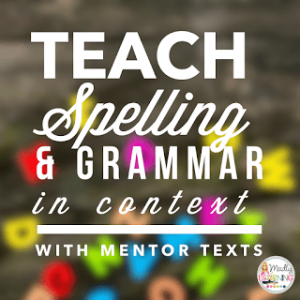
Spelling tests teach kids how to memorize not how to spell. This is why I don’t use spelling tests in my classroom. I am sure that you have been told many times in your teaching career that you need to get rid of your spellers, stop doing spelling tests, and teach kids how to spell in context right?? Of course you have. So you throw out your spellers and promptly never teach kids how to spell a word correctly again (primarily because you don’t know how).
Ok maybe you try but really, you have read their writing…their spelling is horrible, and grammar?? Who needs to know what nouns are anyways. But then you feel guilty because they don’t know what a noun is sooooo….ummmm….. you teach a lesson on nouns. Yes! Eureka! Teacher of the Year for Grammar goes to….. Ok so perhaps this is me or you share a similar cluelessness about teaching grammar and spelling. But you know what I am starting to figure this predicament out I may just have a solution.
It has been my quest to solve the problem of how to teach grammar in context. If you have read through some of my older blog posts you will know that I love picture books and use them in my classroom weekly. You may also know that I have a slightly obsessive need for things to match and coordinate within my classroom. (Yes I colour my staples to match my Bulletin boards…but that is a different story) So this desire to have everything match in my language lessons persists. If I am to teach spelling and grammar in the context where is the context in which I am supposed to teach it.?
Well, I look at a whole picture book and wonder this is so large and there are so many concepts how am I supposed to pick just one to focus on? Which one should I focus on? Then I came across a book by Jeff Anderson called Mechanically Inclined. In his book he talks about teaching the concepts of grammar in the context of good literature such as a picture book but that you need to strip back the layers of the book and just choose a sentence. Just one sentence that highlights a concept in grammar or spelling that students are having a hard time with.
I teach junior so getting into the complexities of comma splices (something I admittedly struggle with) and clauses may be a bit beyond my students’ ability and need. However, they do need to know what a noun and a verb is and how they are used in sentences. How to make complete sentences and where to use a comma. How to use quotation marks, spelling rules for suffixes, homophones, apostrophes for possession or plurals, etc.
Last year I started this with some of the grade 2 students I teach once a day for Core English. (This is a prep coverage – no worries I am not leaving my 4/5 anytime soon.) I started experimenting with simple grammar concepts like nouns and verbs, pronouns etc. I WAS SO IMPRESSED with how well they were picking up age-appropriate grammar concepts. Sometimes I wondered if they had a better grasp of spelling and grammar than my 4s and 5s. I only started using mentor sentences with junior students at the end of the year and although I didn’t see the same progress because I didn’t do it as regularly. These mentor sentence lessons did help students make specific corrections to our final reports that they were writing.
How to Teach Spelling and Grammar With Mentor Texts
A) Look at the curriculum
get a general idea of what spelling and grammar ideas you are expected to cover. Next look at the grades previous to you and determine what they needed prior the grade you are teaching. Make a List. Below is my developmental list for my grade four and five students. Numbers four and five are for my class and the previous parts of the list refer to the grade level expectations prior to my grades.
Spelling and Vocabulary
- High Frequency Words Spelled Correctly short vowels and simple long vowel patterns, rhyming patterns,
- High Frequency Words. Spell words out loud, segment words, sort words by common sound patterns. Follow rules for adding suffixes
- Spell familiar words correctly short and long vowel patterns, visual similarities, rules for changing base word when adding suffix
- Spell subject specific words correctly. Silent letters, syllables, Apply knowledge of vowel patterns to new words. Letter patterns and combinations regular and irregular plurals
- Subject specific vocabulary. silent p divide words into syllables, irregular plurals,
- A capital letter and an ending punctuation mark. Nouns and personal pronouns
- use punctuation question marks, periods, exclamation marks, commas, some quotation marks
- quotation marks, commas, capital letters and final punctuation. Use the parts of speech appropriately Proper Nouns, possessive pronouns, action bears in the present and simple past tense, adjectives and adverbs, and question words
- the apostrophe to indicate possession, and quotation marks to indicate direct speech. Common and Proper Nouns, Simple verb tenses. Subject-Verb agreement adjectives and adverbs, prepositions and conjunctions
- use of the comma beforehand or but used to join principal clauses. Quotation marks for direct speech and punctuation marks placed inside quotation marks. Common Proper and Abstract nouns, collective nouns, adjectives, comparative adjectives, helping verbs. adverbs
B) Use a writing sample.
C) Choose a story and pick a sentence
D) Mini-Lessons and Independent Work
In my Classroom
- Grammar – Using a Mentor Text Sentence
- Spelling – Using a Word Sort
- Writing – Imitation sentences that use the spelling or grammar focus in a new sentence modeled after the Mentor Text Sentence.
- Printing or Cursive –
